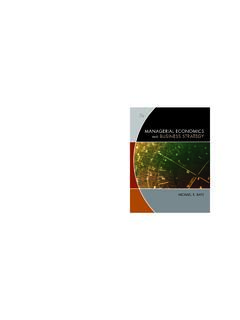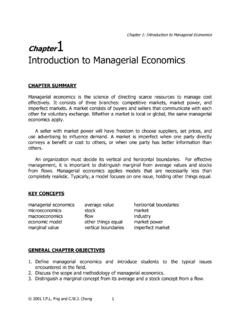Transcription of STUDY MATERIAL OF MANAGERIAL ECONOMICS AND …
1 STUDY MATERIAL OF MANAGERIAL ECONOMICS AND FINANCIAL ANALYSIS JAWAHARLAL NEHRU TECHNOLOGICAL UNIVERSITY HYDERABAD II Year EEE - II SEM L T/P/D C 4 -/-/- 4 MANAGERIAL ECONOMICS AND FINANCIAL ANALYSIS Objectives: To enable the student to understand and appreciate, with a particular insight, the importance of certain basic issues governing the business operations namely; demand and supply, production function, cost analysis, markets, forms of business organizations, capital budgeting and financial accounting and financial analysis.
2 Unit I Introduction & Demand Analysis: Definition, Nature and Scope of MANAGERIAL ECONOMICS . Demand Analysis: Demand Determinants, Law of Demand and its exceptions. Elasticity of Demand: Definition, Types, Measurement and Significance of Elasticity of Demand. Demand Forecasting, Factors governing demand forecasting, methods of demand forecasting. Unit II Production & Cost Analysis: Production Function - Isoquants and Isocosts, MRTS, Least Cost Combination of Inputs, Cobb-Douglas Production function, Laws of Returns, Internal and External Economies of Scale. Cost Analysis: Cost concepts. Break-even Analysis (BEA)-Determination of Break-Even Point (simple problems) - MANAGERIAL Significance.
3 Unit III Markets & New economic Environment: Types of competition and Markets, Features of Perfect competition, Monopoly and Monopolistic Competition. Price-Output Determination in case of Perfect Competition and Monopoly. Pricing: Objectives and Policies of Pricing. Methods of Pricing. Business: Features and evaluation of different forms of Business Organization: Sole Proprietorship, Partnership, Joint Stock Company, Public Enterprises and their types, New economic Environment: Changing Business Environment in Post-liberalization scenario. Unit IV Capital Budgeting: Capital and its significance, Types of Capital, Estimation of Fixed and Working capital requirements, Methods and sources of raising capital - Trading Forecast, Capital Budget, Cash Budget.
4 Capital Budgeting: features of capital budgeting proposals, Methods of Capital Budgeting: Payback Method, Accounting Rate of return (ARR) and Net Present Value Method (simple problems). Unit V Introduction to Financial Accounting & Financial Analysis: Accounting concepts and Conventions - Introduction IFRS - Double - Entry Book Keeping, Journal, Ledger, Trial Balance - Final Accounts (Trasing Account, Profit and Loss Account and Balance Sheet with simple adjustments). Financial Analysis: Analysis and Interpretation of Liquidity Ratios, Activity Ratios, and Capital structure Ratios and Profitability ratios. Du Pont Chart. TEXT BOOKS: 1. Varshney & Maheswari: MANAGERIAL ECONOMICS , Sultan Chand, 2009.
5 2. Siddiqui & Siddiqui, MANAGERIAL ECONOMICS and Financial Analysis, New Age international Publishers, Hyderabad 2013. 3. M. Kasi Reddy & Saraswathi, MANAGERIAL ECONOMICS and Financial Analysis, PHI New Delhi, 2012. REFERENCES: 1. Ambrish Gupta, Financial Accounting for Management, Pearson Education, New Delhi, 2012. 2. H. Craig Peterson & W. Cris Lewis, MANAGERIAL ECONOMICS , Pearson, 2012. 3. Lipsey & Chrystel, ECONOMICS , Oxford University Press, 2012. 4. Domnick Salvatore: MANAGERIAL ECONOMICS In a Global Economy, Thomson, 2012. 5. Narayanaswamy: Financial Accounting - A MANAGERIAL Perspective, Pearson, 2012. 6. Maheswari & Maheswari, Financial Accounting, Vikas, 2012.
6 7. Truet and Truet: MANAGERIAL ECONOMICS : Analysis, Problems and Cases, Wiley, 2012. 8. Dwivedi: MANAGERIAL ECONOMICS , Vikas, 2012. 9. Shailaja & Usha: MEFA, University Press, 2012. 10. Aryasri: MANAGERIAL ECONOMICS and Financial Analysis, TMH, 2012. 11. Vijay Kumar & Appa Rao, MANAGERIAL ECONOMICS & Financial Analysis, Cengage 2011. 12. Prabhakar Rao & Rao, MANAGERIAL ECONOMICS & Financial Analysis, Maruthi Publishers, 2011. UNIT-I INTRODUCTION TO MANAGERIAL ECONOMICS Imagine for a while that you have finished your studies and have joined as an engineer in a manufacturing organization. What do you do there? You plan to produce maximum quantity of goods of a given quality at a reasonable cost.
7 On the other hand, if you are a sale manager, you have to sell a maximum amount of goods with minimum advertisement costs. In other words, you want to minimize your costs and maximize your returns and by doing so, you are practicing the principles of MANAGERIAL ECONOMICS . Managers, in their day-to-day activities, are always confronted with several issues such as how much quantity is to be supplied; at what price; should the product be made internally; or whether it should be bought from outside; how much quantity is to be produced to make a given amount of profit and so on. MANAGERIAL ECONOMICS provides us a basic insight into seeking solutions for MANAGERIAL problems.
8 MANAGERIAL ECONOMICS , as the name itself implies, is an offshoot of two distinct disciplines: ECONOMICS and Management. In other words, it is necessary to understand what these disciplines are, at least in brief, to understand the nature and scope of MANAGERIAL ECONOMICS . Introduction to ECONOMICS ECONOMICS is a STUDY of human activity both at individual and national level. The economists of early age treated ECONOMICS merely as the science of wealth. The reason for this is clear. Every one of us in involved in efforts aimed at earning money and spending this money to satisfy our wants such as food, Clothing, shelter, and others.
9 Such activities of earning and spending money are called economic activities . It was only during the eighteenth century that Adam Smith, the Father of ECONOMICS , defined ECONOMICS as the STUDY of nature and uses of national wealth . Dr. Alfred Marshall, one of the greatest economists of the nineteenth century, writes ECONOMICS is a STUDY of man s actions in the ordinary business of life: it enquires how he gets his income and how he uses it . Thus, it is one side, a STUDY of wealth; and on the other, and more important side; it is the STUDY of man. As Marshall observed, the chief aim of ECONOMICS is to promote human welfare , but not wealth.
10 The definition given by AC Pigou endorses the opinion of Marshall. Pigou defines ECONOMICS as the STUDY of economic welfare that can be brought directly and indirectly, into relationship with the measuring rod of money . Prof. Lionel Robbins defined ECONOMICS as the science, which studies human behaviour as a relationship between ends and scarce means which have alternative uses . With this, the focus of ECONOMICS shifted from wealth to human behaviour . Lord Keynes defined ECONOMICS as the STUDY of the administration of scarce means and the determinants of employments and income . Microeconomics The STUDY of an individual consumer or a firm is called microeconomics (also called the Theory of Firm).








